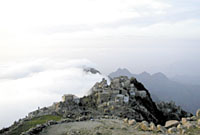
Buraa: Possible world heritage site [Archives:2003/659/Last Page]
August 14 2003
  |
For the Yemen Times
[email protected]
The Buraa forest is listed as a possible UNESCO world heritage site which will if enacted scientifically promote international tourism in the area
The habitat at Buraa is almost unique in Arabia and the best example of valley forest where there is continuous woodland for about a kilometer. It has till now avoided serious disturbances by man.
The rural communities living adjacent to the Buraa forests comprise two distinct and quite different communities. The mountain people (Jabali) inhabiting the mountain tops and higher slopes and growing coffee, qat and barley. The Tihamis, on the plain are growing sorghum as their main crop.
The mountain agricultural area mainly has ample rainfall. While mists and clouds conserve the humidity of the field, plains have limited rainfall. The population of the area is estimated at 10.121. The floods for centuries coming down from the mountains have watered the central Tihamah.
Buraa is also the best example of valley forests where there is continuous woodland for about a kilometer. Buraa is also one of a few examples of a natural vegetation climax found in Yemen partly in their role as a place of refuge for many African savannah species. This is particularly the case with trees.
There are other things to see: Some 12 km SE of Marawiah lies a huge archeological site AlKadra. It was one of the main stops on the road from the south to Najran – and the north n 1357 both Fashal and AlKadra were sacked and razed to the ground, they both never really recovered. It is a huge site that covers an area roughly three by three kilometers. Bricks, cut stones, cement plaster, burnt areas and ash layers can be seen. The site is very rich in surface finds. These include a majority of Rasulid wares, and some porcelain , some celadon etc.. The Tihamah plain may yet reveal significant traces of settlements from several centuries.
——
[archive-e:659-v:13-y:2003-d:2003-08-14-p:lastpage]


